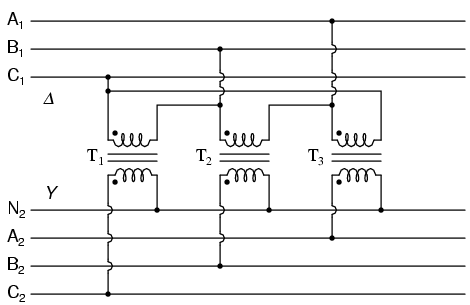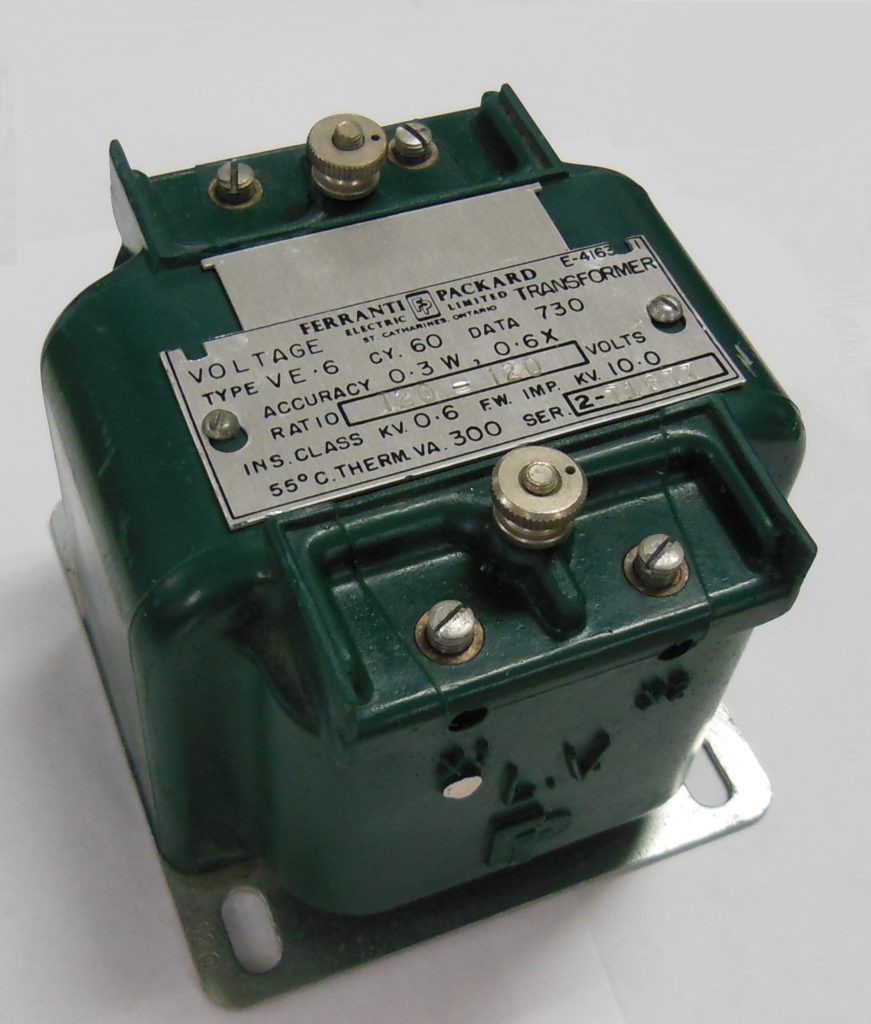In the previous article, we discussed the classification of transformers by core material, geometry and voltage levels. Transformers can also be classified by their application and use. Let's first explore the two broad categories of use cases – transformers used in the electrical domain and transformers used in the electronic domain.
Transformers used in the electrical domain are classified by their applications as follows:
- Power
- Distribution
- Measurement
In the electronics domain, transformers are classified by operating frequency range as follows:
- Pulse
- Audio
- IF
- RF
Power Transformers
Power transformers are used to reduce the line voltage on the 60 Hz utility line. These transformers come in a variety of sizes, shapes, and winding ratios. They can be as big as a room and as small as a Rubik's cube, depending on where they are used, which can range from generating plants and high-voltage power lines to powering electrical appliances. Power transformers are used to convert AC voltages (usually for step-down) from the supply line to electrical circuits or from one part of the supply line to another. These transformers are generally characterized by the maximum voltage and current capacity of the secondary coil.
The largest of these transformers are used in generating plants. Engineers cannot do anything about energy losses due to the resistance of the wires and the power consumed by the loads. This leaves them with the option of transmitting high voltage power through transmission lines. The higher the voltage, the lower the current, so energy losses are minimized in power transmission. Power transformers in generating plants convert high-current low voltages into high-voltage, low-current AC. High-energy plants have larger power transformers that can transfer power up to 100 MVA through the transmission line. Medium power transformers have a power rating typically of 50 to 100 MVA, while small power transformers used in local power stations have a power rating typically of 500 to 700 KVA.
Power transformers are larger than distribution transformers. They are designed to be maximum energy efficient as they remain charged 24 hours a day. Such power transformers can be connected directly to the consumer or can be connected to a distribution network. Most power transformers have a three-phase configuration, while some small power transformers may have a single-phase configuration. Three-phase power transformers are expensive, although they are very energy efficient compared to single-phase transformers.
Transformers are used at different points in transmission networks. High voltage lines carry voltages in KV or MT, which cannot be supplied directly to the consumer. Power transformers are deployed to reduce these voltages to lower voltages at the branch points. The reduced voltages are further reduced within the network. Finally, the AC voltage is stepped down to 230V or 120V three-phase RMS by distribution transformers to supply the end consumer.
Small sized power transformers are used in the power section of electrical appliances to further step down the AC grid to low voltages ranging from 5V to 50V. Most home appliances require 5V to 12V to operate with minimum current consumption. Different power transformers come in a variety of constructions, configurations and sizes.
Automatic transformers
Autotransformers are power transformers that have a primary and secondary in a common coil. Both the primary and secondary are on the same coil and have the same direction. The voltage is varied by changing the position of the secondary tap.
Single-phase and three-phase transformers
Power transformers can have a single-phase or three-phase configuration. Single-phase transformers have a single pair of primary and secondary windings. These transformers are generally used in electrical appliances, where they convert voltage levels at a constant frequency.
Three-phase transformers have three pairs of primary and secondary windings connected together. These transformers are economical compared to single phase transformers when used in power generation, transmission and distribution. The primary and secondary coils in three-phase transformers can have various combinations of star and delta connections, such as star-star, star-delta, delta-delta, or delta-star connections in the primary and secondary windings, respectively.

Schematic representation of a typical three-phase transformer (Image: Quora)
Distribution transformers
Distribution transformers are used in power distribution networks to reduce transmission line voltages to less than 33KV for industrial purposes and 230-440V for domestic purposes. They are generally used at the end of a distribution network as pole-type transformers and can also be pad-mounted or underground transformers at the distribution end. They are small, not always fully loaded, and may have dry or liquid-immersed insulation. They can provide single-phase or three-phase main power supply to the end consumer. These transformers are low cost and designed to be 50 to 70 percent energy efficient.
Measuring transformers/instruments
Instrument transformers are used to measure high value current and voltage and are used together with low range measuring instruments as precise ratio transformers. These transformers convert high voltage or current to low voltage or current by a precise ratio that can be measured by a typical ammeter, voltmeter, or wattmeter. These can be current transformers that are intended for use with an ammeter or potential transformers that are intended for use with an AC voltmeter.

A 120:120 instrument isolation transformer showing two polarity marking conventions (Image: Wikipedia).
These are essentially isolation transformers that safely isolate the supply line with the measuring instrument. The power line voltage is precisely reduced by a high rotation ratio to a lower voltage so that a typical measuring instrument can easily measure it. Current transformers are connected in series to the supply line to measure current. The supply line current is measured as the sum of the excitation current and secondary current multiplied by the turns ratio. Current transformers with lower precision are also used as protection transformers.
To measure high value voltages, the primary of potential transformers or potential transformers is connected to the supply line and the supply line voltage is reduced to a safe limit on the secondary. Voltage transformers can be electromagnetic, capacitor or optical types. Electromagnetic types are single-wire step-down transformers, capacitor types use a capacitor voltage divider, and optical types use optoelectronic components.
Pulse Transformers
Pulse transformers are small-sized PCB-mounted transformers used in electronic devices to generate pulses of fixed amplitude. These transformers isolate a digital load circuit and supply pulses of constant amplitude to it.
Audio Transformers
It is more appropriate to classify transformers used in the electronics domain by the frequency range of their operation. Electronic transformers that operate in the frequency range of 20 Hz to 20 kHz are classified as audio transformers. These are generally small utility transformers with a laminated EI core similar to typical 60 Hz utility transformers. These can be step-up or step-down transformers. Audio transformers are primarily used for impedance matching and are designed to offer almost zero reactance. There may be multiple primary and secondary coils in an audio transformer, which may be separate or center-tapped.
SE Transformers
IF transformers are used to tune intermediate frequency signals. They are shielded transformers, generally with a high permeability ferrite core.
RF Transformers
Electronic transformers used at radio frequencies are called RF transformers. These may be wirewound transformers, such as utility transformers, or they may be transmission line transformers. Wirewound transformers with toroidal powdered iron cores are the most common. Air core RF transformers are used for high power applications. Although powdered iron core transformers have high permeability and self-protection, air core transformers are much more energy efficient although they have significant EMI. These transformers are also called wideband transformers and are used for a frequency range of 3 MHz to 30 MHz. At higher frequencies, transmission line transformers are used as quarter-wave antennas. These can be parallel wire lines or coaxial cables.
Transformer Applications
Transformers are widely used in the electrical and electronic domain. In the electrical domain, transformers are generally used to reduce AC voltages in power stations, distribution networks or for measurement. In electronics, transformers are used for many applications such as increasing or reducing voltages, impedance matching, pulse generation, coupling and isolation.
Transformers used in the electronics domain usually have their specifications such as primary voltage, secondary voltage, and power rating printed on them. In general, color schemes identify the primary coil, secondary winding, and center tap terminals.
Activity 12
That's enough about transformers. Now that you know the operation and specifications of transformers, it's time to try out some circuits. Get the circuit diagrams and get your hands dirty with some of the hobby circuits that use transformers like half wave rectifier, full wave rectifier, 12V or 9V symmetric bench power supply, audio power amplifier and preamplifier. Inspect the function and required specifications of transformers used in these circuits.
Activity 13
Prepare a list of some pulse generating transformers by their part numbers. Download and inspect your data sheets. Discover important electrical characteristics mentioned in their technical sheets that may be useful in your application.
In the next article, we will discuss power supplies.

